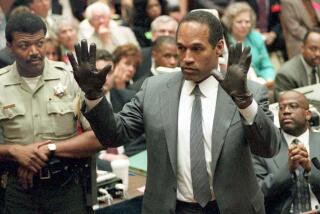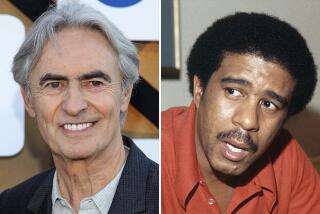TELEVISION REVIEW : Bill Moyers Barks at the Watchdogs : Journalist delves into what Project Censored’s national panel of journalism experts has selected as the ’10 best-censored stories of 1990.’ It’s an unsettling but invaluable hour of TV.
Every day you can pick up the newspaper or tune in the evening news and find stories about crime and corruption, death and destruction. What could be scarier?
How about the stories we don’t hear about?
Those are the focus of a Sonoma State University communications program called “Project Censored,” which is in turn the subject of Bill Moyers’ latest report for PBS, airing tonight at 8 on KOCE Channel 50.
“Moyers/Project Censored” delves into what Project Censored’s national panel of journalism experts has selected as the “10 best-censored stories of 1990.” It makes for an unsettling, but invaluable, hour of television.
One of these stories is a scientific report that a single NASA space shuttle launch is doing more harm to the ozone layer that protects the Earth from ultraviolet radiation than a year of emissions from an industrial factory.
Another suggests that the nation’s savings-and-loan debacle merely sounded the starting gun for an even larger national financial crisis, because “the nation’s banks are facing the same problems, the same economic conditions and the same accounting gimmicks that brought down the savings and loans.”
A third explores the Pentagon’s secret “black budget,” a multibillion-dollar appropriation for weapon systems and programs that few members of Congress, let alone average citizens, even know about.
The really frightening thing about these stories is that for the most part, the censoring comes not from the government but from the media themselves. For various reasons, the mainstream press, for all its tenacity in dogging the heels of greedy public officials or shady business dealings, ignores some major stories--the ones Project Censored has been highlighting for the past 15 years.
How is this possible? In some cases, it seems, the stories simply are too difficult. The Houston Post’s Pete Brewton, who has reported extensively on organized crime and CIA connections to the failures of numerous S&Ls;, says that “taking on the CIA is like taking on a big prickly pear. . . . It’s dangerous and it’s hard, and there’s no ‘smoking gun’ in the form of a document that says ‘Yes, this money went to one of our activities.’ If it was easy, (other news organizations) already would have done it. It took us a year to even start writing stories.”
In the final segment of the program, Mike Moore, editor until recently of The Quill, the official publication of the Society of Professional Journalists, discusses what Project Censored named as “the No. 1 under-reported story of the year: The press’s failure to acknowledge its own uncritical coverage of the (Operation Desert Shield) buildup.”
“Journalists and editors like to portray themselves as watchdogs. . . . If you portray yourself as a watchdog, you’ve got to bark once in a while,” Moore says. “You’ve got to bark before the S&Ls; get into terrible jeopardy; you’ve got to bark before we’ve got 400,000 to 500,000 troops in the Mideast.
“We’re not doing much barking. We’re too often lap dogs.”
Some of these under-reported stories are less compelling than others, at least in the way they are presented here. Former undercover Drug Enforcement Administration officer Michael Levine’s allegation that the “war against drugs” is a fraud, another story highlighted by Project Censored, certainly is hot stuff. But its credibility is subject to considerable debate, given that it’s provided here by only one source: Levine, who has a vested interest in the form of profits from his book on the subject.
The biggest complaint that can be made about “Moyers/Project Censored” is that it commits one of the very failings it accuses other journalists of: It doesn’t ask tough questions of the right people. No editors or reporters from major news organizations are asked why they have chosen not to cover these issues.
Perhaps time was a constraint. One hour is little enough as it is to try to touch on all 10 of Project Censored’s “winners.” Nevertheless, there’s one thing you can say about Bill Moyers: He barks.
More to Read
The complete guide to home viewing
Get Screen Gab for everything about the TV shows and streaming movies everyone’s talking about.
You may occasionally receive promotional content from the Los Angeles Times.






